Related Research Articles

Myrciaria is a genus of large shrubs and small trees described as a genus in 1856. It is native to Central and South America, Mexico, and the West Indies, with many of the species endemic to Brazil. Common names include hivapuru, sabará, and ybapuru.
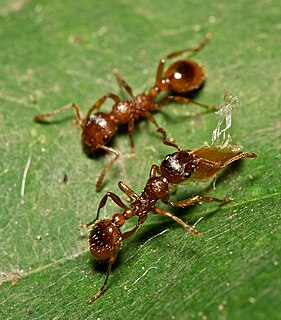
Myrmica is a genus of ants within the subfamily Myrmicinae. It is widespread throughout the temperate regions of the Holarctic and high mountains in Southeast Asia.
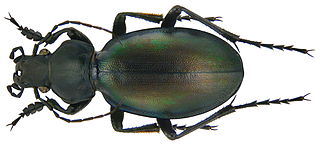
Carabus torosus is a species of black-coloured ground beetle in the Carabinae subfamily that can be found in Bulgaria, European part of Turkey, and Near East.

Vexatorella is a genus containing four species of flowering plant, commonly known as vexators, in the family Proteaceae. The genus is endemic to the Cape Floristic Region of South Africa. The name means “little trouble-maker”, given with reference to the initial difficulties of placing V. latebrosa within the family. All species are shrubs which occur in dry fynbos habitats on the fringes of the Succulent Karoo ecoregion. The inflorescences are similar to those of the related leucospermums but also share features of the leucadendrons, with the floral bracts becoming woody and enlarged following pollination. The flowers are insect-pollinated, with the seeds dispersed by ants (myrmecochory).
Abacetus vexator is a species of ground beetle in the subfamily Pterostichinae. It was described by Peringuey in 1904.
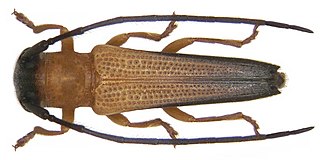
Nupserha is a genus of longhorn beetles of the subfamily Lamiinae, containing the following species:

Toxicodryas is a genus of rear-fanged venomous snakes in the family Colubridae.
Nupserha vexator is a species of beetle in the family Cerambycidae. It was described by Francis Polkinghorne Pascoe in 1858. It is known from Sri Lanka.
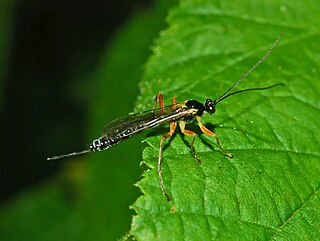
Polysphincta is a genus belonging to the family Ichneumonidae subfamily Pimplinae.

Callipallene is a genus of sea spiders in the family Callipallenidae. There are more than 30 described species in Callipallene.

Leucospermum secundifolium is a low, evergreen shrub that grows along the ground, the tip of the branches slightly rising, which has been assigned to the family Proteaceae. It has narrowly elliptic leaves with a distinct leafstalk, and few-flowered and very small heads of 1–1½ cm (0.4–0.6 in) across. It is called stalked pincushion in English. The sweetly scented flower heads may be found around early December. It is an endemic species that only grows in a small area of the Western Cape province of South-Africa.

Vexatorella alpina, the Kamiesberg vexator, is an evergreen, upright shrub of up to about 1½ m high, in the family Proteaceae. It has entire, long inverted egg-shaped, bluish grey, leathery leaves of 3–4½ cm (1.2–1.8 in) long and 5–13 mm (0.2–0.5 in) wide on a distinct stalk, and globular flower heads of about 2 cm (0.8 in) across at the tip of the branches, and consisting of pale pink flowers with extended, thick-tipped styles. The plants are flowering from September to November. It is an endemic species that is restricted to the Kamiesberge in South Africa.

Vexatorella amoena, also known as the Swartruggens vexator is an evergreen shrub of up to about 1 m (3 ft) high, that is assigned to the family Proteaceae. It has entire, inverted egg-shaped, bluish grey, leathery leaves of 1½–3 cm (0.6–1.2 in) long and 5–11 mm (0.20–0.45 in) wide on a distinct stalk, and globular flower heads of about 2 cm (0.8 in) across with pale pink flowers with extended, thick-tipped styles at the tip of the branches. The plants are flowering from September to November. It is an endemic species that is restricted to the Western Cape province of South Africa.

Vexatorella obtusata is an evergreen shrub, with narrow, leathery leaves and about 2 cm big, globular flowerheads consisting of well scented, creamy pink flowers, from which a long style with a thickened tip extends. Two subspecies are distinguished, both restricted to different parts of the Western Cape province of South Africa. The creeping V. obtusata subsp. obtusata, also known as the Montagu vexator flowers from September to December, and the upright V. obtusata subsp. albomontana, also known as the Witteberg vexator, that has flowers between August and November.
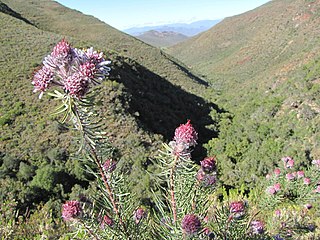
Vexatorella latebrosa, also known as the Robertson vexator, is an evergreen, upright shrub of up to about 1½ m high, from the family Proteaceae. It has entire, long inverted egg-shaped, bluish grey, leathery leaves that are line-shaped to very narrowly spade-shaped in outline, 5–6½ cm (2.0–2.6 in) long and 2–3 mm (0.08–0.12 in), and mostly solitary globular flower heads at the end of the branches of 2½–3 cm (0.8 in) across with scented, pink to carmine flowers with extended, styles with a thickened tip. The plants are flowering from August to September. It is an endemic species that is restricted to the Western Cape province of South Africa.

The Vexator Canadiensis tokens are thought to be politically satirical tokens produced in either Quebec City or Montreal sometime in the 1830s. The tokens present a very crude image of a vaguely male bust on their obverse, and a female figure on the reverse. The legends on either side were deliberately designed so that they are hard to definitively read, but are commonly known as the "vexators" based on a common interpretation of its obverse legend. Depending on the interpretation of the inscriptions, they can either be taken as a form of satirical protest against either an unpopular Upper Canada governor, or William IV as a "tormentor of Canada", or more simply, depicting a fur trapper. Since all of these interpretations are possible, the ambiguity would allow the issuer from escaping being cited for sedition.

Myrciaria vexator, the false jaboticaba, or blue grape tree, is a species of plant in the family Myrtaceae.
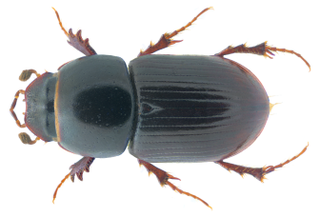
Calamosternus is a genus of scarab beetles in the family Scarabaeidae. There are more than 20 described species in Calamosternus.
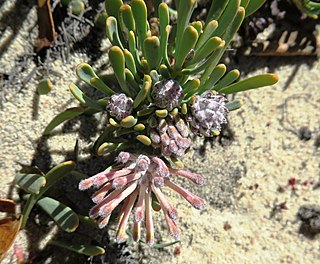
Vexatorella obtusata subsp. obtusata, the Montagu Vexator, is a flower-bearing shrub that belongs to the genus Vexatorella and forms part of the fynbos. The plant is native to the Western Cape and occurs in the Hex River Mountains, Bokker River Mountains, Keeromsberg and Kwadouw Mountains to the Langeberg at Koo as well as the Waboomsberg. The shrub is dense and grows to 2.0 m in diameter. The shrub blooms from September to December.

Vexatorella obtusata subsp. albomontana, the Witteberg vexator, is a flower- bearing shrub that belongs to the genus Vexatorella and forms part of the fynbos. The plant is native to the Western Cape and occurs in the Witteberg, Bonteberg and Anysberg. The shrub is erect and grows to 1.0 m in length. The shrub blooms from August to November.
References
- ↑ Biolib.cz - Diliolophus vexator. Retrieved on 8 September 2014.